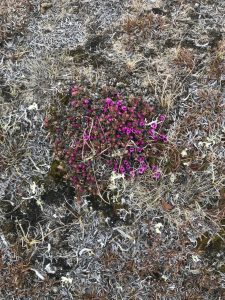By Jordan Stewart
Despite the many uncertainties and challenges of the past year, research as the Churchill Northern Studies Centre has not skipped a beat. Whether it be conducting in-house research, collaborating with researchers from across Canada, or finding new ways to share our scientific passions and discoveries to the public, the CNSC Science department has had a busy winter with no signs of slowing down as the summer approaches.
This winter, the CNSC completed 2021 data collection for several long-term monitoring projects. For long term studies – especially studies monitoring the influence of climate change – it is imperative that data be collected every year to maintain the integrity of these projects. One such project that the CNSC looks forward to every year involves collaborating with Earthwatch teams to investigate the influence of climate change on the diverse Churchill ecosystems. Earthwatch gives volunteers from all over the world the opportunity to team up with scientists, and not only learn about conservation in the sub-arctic, but also participate in conservation as well. Without the help of Earthwatch volunteers this year, the onus fell on the shoulders of CNSC Science staff. Throughout the winter months we spent long days in the field measuring snow depth and density, classifying snow layers, and collecting new growth branches on spruce trees.
We also completed another year of data collection for several researchers that contract out the CNSC science services. For example, we conducted another year of ice surveys on Ramsey Lake for Environment Canada. This involved a full day of drilling through ice to measure snow thickness, white ice (snow mixed with ice) and l ice thickness.
A highlight for all CNSC staff is getting to share our passion for subarctic science to visitors to the CNSC. This winter, we were still able to share these passions through virtual webinars and presentations. The CNSC Science team produced several virtual Science Stations showing off CNSC’s insect, bird, and skull collections, as well as sharing some of the current research being done at the CNSC.
Heading into the summer months there is no sign of science slowing down – melting snow and receding ice open a whole new world of research to be explored! As the snowy Churchill landscape slowly gives way to the many colours of the tundra, you can often find CNSC staff searching for early signs of plant life. This is all to collect data for the International Tundra Experiment (ITEX), a project that spans circumpolar regions across the globe and explores the influence of increasing temperature on the growth of tundra plants. For over 15 years, the CNSC has been observing the growth stages of three different plant species in three different ecosystems throughout the spring and summer, and this will be continued for the 2021 season.
In addition to snow melting, the sea ice on Hudson Bay is starting to slowly break-up, marking the start of marine related research at the CNSC. One of which is conducting shore-based ringed seal surveys for researchers from the Assiniboine Park Zoo. The first round of seal counts are currently being conducted with many more to come.
This summer, we will also be getting the CNSC Hudson Bay Marine Tank up and running again after being out of commission for over a year. We will be collecting various marine animals from the Churchill River Estuary to showcase local near-shore marine and tundra pond species to visitors and Churchill school groups.
Finally, the CNSC looks forward to once again be participating in the 4+1 program at the Duke of Marlborough Highschool in June. This summer will feature an actioned packed week of learning about eco-tourism, polar bear monitoring, birding, belugas, and many more exciting topics.
While far from normal, the CNSC science team is gearing up for another exciting and science packed summer. We continually look forward to the day when we can welcome visitors to the CNSC and share stories of our latest adventures and discoveries.



